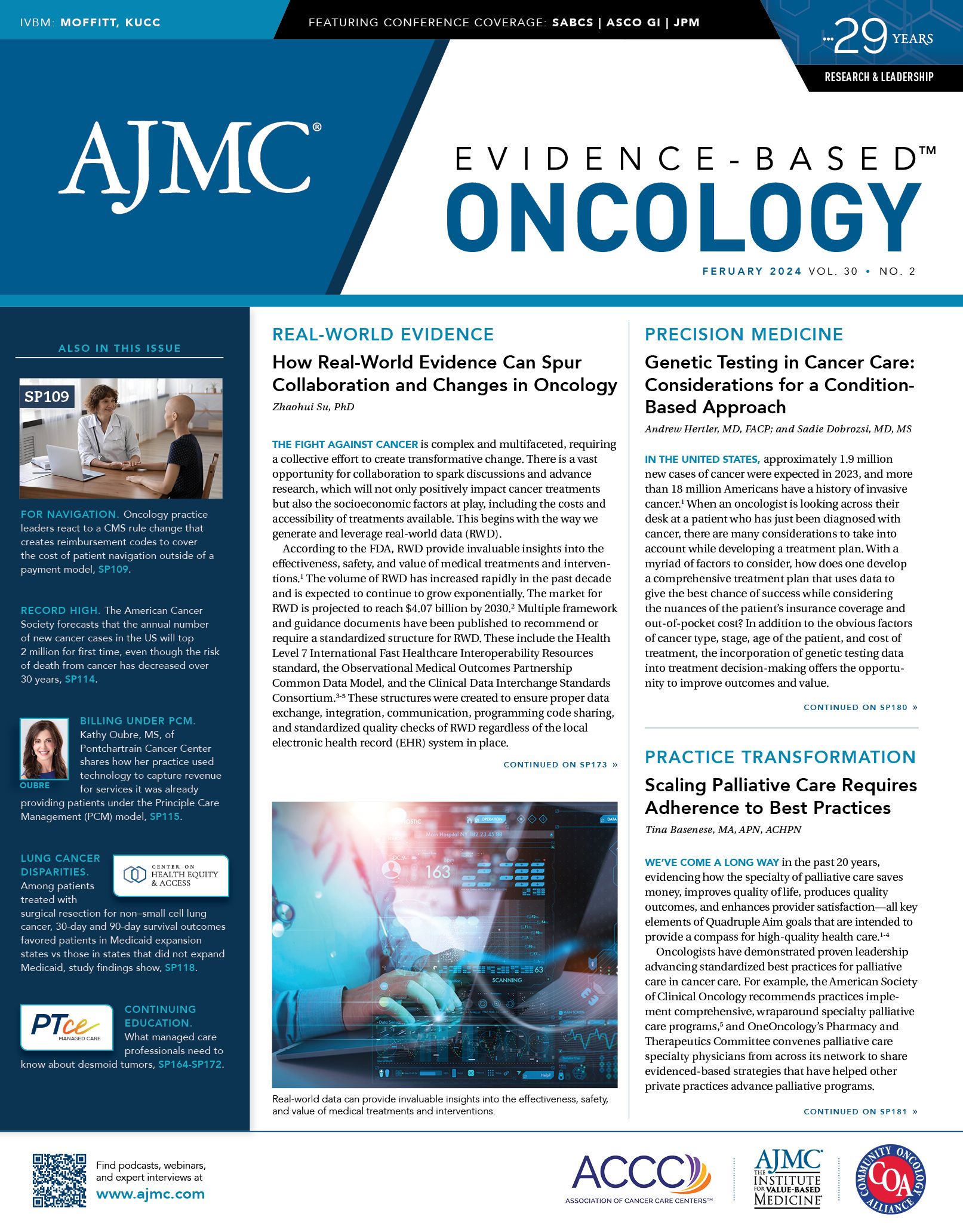Publication
Article
Technology Helps Community Oncology Practices Implement PCM, CCM
Author(s):
In 2015, CMS created a unique payment model that would allow practices to bill for care management, those services that help patients with a single high-risk condition or multiple chronic diagnoses stay out of the hospital.1 Care management includes things such as symptom monitoring or calls to check that patients are taking their medications.
However, even though physicians had talked for years about the cost of care coordination activities, they were slow to adopt both the first model,1 Chronic Care Management (CCM),2 designed mostly for primary care providers, and a second model, Principal Care Management (PCM), designed in 2020 for specialties such as oncology that address a single condition.3
The reason? Getting paid under both models required lots of documentation, and many practices felt it wasn’t worth the effort. But now technology is available that operates alongside the electronic health record (EHR) to more seamlessly assemble the documentation needed for CMS reimbursement under both PCM and CCM, which have been shown to improve outcomes.
Chantel Hopper, MBA | Image: LinkedIn

Canopy Care, a company started in 2018 to build intelligent health platforms, offers oncology-specific tools that integrate its care management platform with the practice’s EHR to monitor and improve patient care without overburdening staff.
Kathy Oubre, MS | Image: LinkedIn

These tools help practices facing Medicare cuts elsewhere capture payments for services they may be providing already.4 Canopy’s internal data show up to one-third of the billable time attributed to PCM requirements involves services that practices are already providing.5
That was certainly true for Pontchartrain Cancer Center (PCC), a small practice with 2 sites in southeast Louisiana. Canopy partnered with PCC to bring the platform into the community oncology practice, which had unsuccessfully tried to implement PCM on its own. In late January 2024, Chantel Hopper, MBA, head of marketing and customer success for Canopy, and Kathy Oubre, MS, CEO of PCC and an editorial board member for Evidence-Based Oncology, hosted a webinar to discuss how the Canopy implementation process occurs in a practice, the benefits for various oncology stakeholders, and ways the tool could be improved in the future.
For practices that were part of the Oncology Care Model, and either did not join the Enhancing Oncology Mode or are seeing less revenue, using Canopy’s tools for PCM and CCM payments can help replace lost Monthly Enhanced Oncology Services payments, Hopper explained. For this reason and others, she said, “I think we’re hearing a lot more about these codes, and practices are considering them a lot more.”
However, she said, using care management models isn’t all about revenue—evidence shows that using PCM and CCM also leads to better outcomes. “I think we always want to lead with [what’s] good for patients. The idea of proactive patient management makes complete sense” because it encourages earlier detection of problems, allowing for interventions that prevent hospital stays. “And it reduces costs not just for the system, but also for the patient,” she said.
Oubre explained how using the platform helped her practice achieve overall goals: increase remote care services, enhance patient care, and reduce health care costs. Canopy, she said, allowed PCC to do this while automatically capturing billable activities to ensure maximum reimbursement benefits, which helped patients, staff, and physicians.
A key requirement of both PCM and CCM is that patients must consent to be part of the model. Thus, practices must walk patients through the services covered; those without supplemental coverage may not agree to opt in because of co-payments. When PCC and other practices first tried to implement PCM, the documentation was done by hand on paper, and enrollment rates were low. Early technology solutions did not help. Oubre explained that this caused hesitation among her staff about using another tool. But as reduced reimbursement in other areas shrank profit margins, the practice gave PCM a fresh look.
This latest effort is working, Oubre said. At the 1-month mark following implementation, PCC achieved a 65% opt-in rate among 60 patients, without any additional hires.5
Some oncology practices also bill under CCM, which can be used under specific circumstances, but individual patients can qualify for 1 model only. Regarding CCM, Oubre said, “It seemed like too big of a lift for our organization. We made the decision to adopt PCM, bring it to the organization, do it well, and then consider CCM programs in a year or so.”
As PCC switched from 1 system to 2 with the addition of Canopy, user accessibility was highlighted as a key feature. The “easy button,” as Oubre calls it, offers bidirectional integration. End users can click either Canopy or the data management system, OncoEMR, in the patient’s chart or page.6 Doing so takes the user directly to the corresponding page in the oncology data management system.
Oubre explained that the simplicity of Canopy alleviates the anxiety some users may have about using technology. At PCC, Oubre was able to distribute the various PCM data-collection tasks among the staff and integrate them into the daily workflow.
“We like Canopy,” she said. As users have become more comfortable with the platform, data collection has become more efficient. Staff use Canopy while making monthly calls to patients required under PCM. “It’s really documenting and getting paid for things that we do every day to care for our patients,” Oubre said.
She stressed how workflow is often completed through staff teamwork and compromise. Extending an open form of communication is beneficial to this process because employees can learn their professional strengths while improving colleague bonding. Overall, she said, time management skills are not something technology can replace, and she highlighted some bumps in the implementation process.
“Our implementation wasn’t perfect,” Oubre said. At first, the staff put off required calls until the end of the month, and in a short month such as February, the calls piled up. As the practice worked on improving the rhythm, the phone calls became more consistent, and both patient and employee satisfaction improved.
“It has helped patient satisfaction,” Oubre said. When there is a positive Google review or a kind comment about a medical assistant, she said, “You share those wins internally, because everyone wants to feel validated for what they do.” It helps “just to call out that what you’re doing makes a difference,” she added.
Oubre shared some examples of overcoming staff resistance. In one case, a medical assistant whom Oubre knew to be a “social butterfly,” had low enrollment numbers. It turned out she didn’t like the phone script. So Oubre worked with the staff member to change the language to reflect how she spoke with the patients, and it was delivered more comfortably.
“It all goes back to staff buy-in,” Hopper said. “If the staff truly believe in the value of the program to the patient, [this] comes across to the patient as very authentic and genuine.” Instead of patients feeling that they are being sold something, they are hearing a recommendation from someone they trust, Hopper said.
Dashboards Are a Key to Success
Canopy’s dashboard feature is used weekly to “keep an eye on programs and tackle barriers or perceived barriers before they become hard to unwind,” Oubre said. “The staff knows that it’s not meant to be a punishment.”
Using this real-time feedback, the practice can rework the phone script or tweak workflows, Oubre said. “We find those dashboards to be very helpful in helping make this program the success that it has been for us.”
So far, PCC staff prefer Canopy compared with other care management platforms because it has more automation tools, allowing them to complete their work quickly. The staff no longer feel intimidated and even offer suggestions for improvements, such as better ways to document tasks unrelated to the phone calls. Oubre said she looks forward to using Canopy to implement reimbursement for patient navigation.
Oubre said Canopy listens to all practice feedback and works to improve patient, practice, and staff experiences. As health care evolves, she said, that responsiveness will be essential. “If I have to look at all the things that we’ve brought into the practice over the past several years, this was probably an easier lift than I thought it would be, with higher success,” she said.
Mary Caffrey contributed to this report.
References
1. Schurrer H, O’Malley A, Wilson C, McCall N, Jain N. Evaluation of the diffusion and impact of the Chronic Care Management (CCM) services: final report. CMS. November 2, 2017. Accessed January 30, 2024. https://go.cms.gov/48TUje6
2. Chronic care management. American Academy of Family Physicians. Accessed January 30, 2024. https://bit.ly/3OoFzvw
3. Principal Care Management (PCM) CPT billing code summary. Healthsnap. Accessed January 30, 2024. https://healthsnap.io/resources/pcm-billing-overview/
4. A platform built for care. Canopy. Accessed January 30, 2024. https://www.canopycare.us/
5. Hopper C. Enhancing continuous care: implementing a principal care management program at Pontchartrain Cancer Center. Canopy. December 14, 2023. Accessed January 30, 2024. https://www.canopycare.us/blog/pcc-case-study
6. ONCO. Accessed January 30, 2024. https://www.oncoinc.com/





